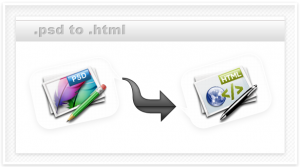Understanding PSD Conversion Tactics
 Today, the battle for topping SERPs is much fiercely competitive than ever before. Online audiences have become more choosy and tech-savvy. Each time they look for a website or a piece of information, the need to have something uniquely interactive and attractive to the eyes is a critical aspect. Photoshop data is one best way to capture vivid images, however, these data needs to be converted into a code that can be recognized by the worldwide web. Think about posting a French short story in a Spanish-only blog site. For the story to be understood by your French-speaking audience, the need to translate it into Spanish is essential. Such is the case of PSD conversions. By converting Photoshop-based designs into a web intelligible mark-up language, this can be easily “understood” by the web and delivered effectively and vividly to your online audience. From From PSD to HTML, XHTML, Joomla, Drupal, WordPress and many more, understanding each concept and notable advantages can be a great help.
Today, the battle for topping SERPs is much fiercely competitive than ever before. Online audiences have become more choosy and tech-savvy. Each time they look for a website or a piece of information, the need to have something uniquely interactive and attractive to the eyes is a critical aspect. Photoshop data is one best way to capture vivid images, however, these data needs to be converted into a code that can be recognized by the worldwide web. Think about posting a French short story in a Spanish-only blog site. For the story to be understood by your French-speaking audience, the need to translate it into Spanish is essential. Such is the case of PSD conversions. By converting Photoshop-based designs into a web intelligible mark-up language, this can be easily “understood” by the web and delivered effectively and vividly to your online audience. From From PSD to HTML, XHTML, Joomla, Drupal, WordPress and many more, understanding each concept and notable advantages can be a great help.
PSD to HTML
As mentioned, Photoshop data can be hard to understand on the web. Browsers often have certain limitations that sometimes make it less likely to load PSD files without converting it first to HTML, the very building block of websites. By converting PSD to HTML, high quality semantic code can be attained to help clean-up a usually cluttered website concept. As websites are predominantly dependent on SEO for traffic, conversion makes sure that you have SEO-friendly code and get good rankings on SERPs. W3C validation is one important aspect that must also be on top of your website’s design. Once validated, it can be easily recognized as an authentic website with trustworthy content. Of course, its efficiency in delivering cross-browser compatibility will help one be enjoyed by common online users which presumably use different browsers.
XHTML Conversion
PSD to XHTML, on the other hand, enjoys the same advantages only on a much advanced level. XHTML is HTML’s more advanced version providing interactive aspect never before realized in plain HTML versions. By converting Photoshop data into XHTML, developing hyper-dynamic websites and applications came into existence. Pixels in pictures are more pixel-perfect. Videos, deemed impossible to imbed on plain HTML, are successfully entrenched giving audience a more interactive feel. Today, however, there are new versions of HTML that are considered at par with XHTML marked up language. XHTML is also continually being developed. XHTML1, for instance, is a reformulation of three HTML4 document types. Today, an ongoing debate on which is better XHTML1 or HTML5 has continually spark interest among web developers.
Blogger Savvy
For the blog-savvy web developer, WordPress is one reliable Content Management System that has continually been used in online promotion concepts. Some people would appreciate story-like content instead of objective and formal write-ups or press releases. With this converting PSD to WordPress is one consistent aspect that most bloggers continually reach out to. The best thing about converting PhotoShop Data into WordPress is in its ability to deliver websites that are user-friendly and accessible with zero spam content.
Indeed, it is an important aspect for any business to select the best PSD conversion in developing its website. Apart from coming up with a website that attracts traffic like flies to a pancake, the need to consider budget requirements must also be taken into mind.
- Comments
- Leave a reply
